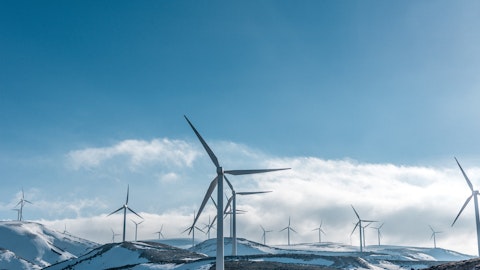And then the other slide that was very compelling was showing basically a significant — significant cost advantage for refueling infrastructure as compared to recharging infrastructure for the fleet of buses. And this was a pretty interesting case study. So to me, you’ve got cities like New York, Chicago, Las Vegas, Philadelphia, that are really talking about fuel cell buses in a way they haven’t before. And I think we are now seeing the — an inflection point in market understanding that will translate to orders longer-term. I do think that the hydrogen — the available low-cost, low-carbon hydrogen in the U.S. market will be a massive enabler from a cost perspective for the total cost of use and we see some of these hydrogen hubs potentially being able to contribute likely in the midterm, so kind of 3- to 5-year time frame.
In terms of the timing for buses in the U.S. market, I would still characterize it as deployments in the 20 to 120 range per city per announcement of project over the next few years. But from 2025 through 2029, we are going to see a very significant shift as the California transit buses with the ICT policy are required to effectively go zero emission for all new transit buses by 2029. So I think we’re going to see this significant scaling from 2025 to 2029. And it won’t be just in California. It’s across the U.S. now where we’re seeing these opportunities emerging.
Rob Brown: Okay. And could you update us on your thoughts about having U.S. production capacity? Are you — where is that at, at this point?
Randy MacEwen: Yes. Rob, we’re still working against that and doing our comparative analysis, looking at the European market, looking at the U.S. market, looking at the relative advantages and incentive support that’s available in the market. We expect to conclude most of that work late this year, but we did indicate we probably would be Q1 next year before we’re in a position to make a final determination. As you can appreciate, there’s been a number of companies applying for U.S. funding opportunities to scale clean energy technologies, including fuel cells and electrolyzers and the agencies that have funding available to support these type of manufacturing expansion plans are quite busy managing these applications. So we are in an application process. I don’t know if we’ll be successful or not. But we do see that the timing on response for funding agencies has been protracted.
Operator: The next question comes from Mac Whale with Cormark Securities.
Mac Whale: I’m wondering, the backlog — the new orders looks a little bit weak given where the backlog and where the orders came in. Is there a shift from your customers maybe to shorter-term focus and — because your guidance on kind of the split versus second half in terms of revenue looks like you’re still expecting some good sequential growth. So can you kind of reconcile those two elements of the results?
Randy MacEwen: Yes. I think that’s a fair characterization. We did see weak order intake in the quarter. What I’d point to, though, is the sales pipeline. And if I was to characterize the sales pipeline, Mac, there’s 3 terms I’d use. It’s growth, progression and diversification. We’re seeing, in the quarter, over 10% growth in a very large sales pipeline already. More importantly perhaps, we’re seeing significant progression of opportunities through different stages of the pipeline. And on the diversification front, we’re seeing really significant contributions into the pipeline from all of the different verticals, particularly with bus, truck and rail in aggregate contributing about 75% of the total sales pipeline. So we see a pretty good diversification in that pipeline.
We do see also some very lumpy projects in marine and stationary that could be significant adders to the order book and the revenue outlook as we move forward. Those are still in earlier stages. So I’m actually — notwithstanding the weak order intake in the quarter, I’m very encouraged by what I’m seeing on the end-market interest and on the sales activity and the progression and growth of the sales pipeline. I would characterize this more as a timing issue. We see orders coming in, in Q4 and into early next year.
Mac Whale: Okay. That’s helpful. And then I just thought I would — I think Paul mentioned already — sort of gave an update on the breakeven on the margin basis with reference to the September Analyst Day. I’m wondering on one of the other goals in the Analyst Day that you talked about was expand across the value chain. Are you — given the write-down, are you thinking — or what are you thinking about in terms of tweaking that expansion? Like do you — are there different areas now that you need to go into or you think are more likely you’ll go into versus, say, third-party integration? Like is there a shift there going on?
Randy MacEwen: Yes. Mac, I think you’ve highlighted this. A couple of years ago, we were investing in a couple of strategic themes, one of them being selectively expanding across the value chain. And we have seen this shift in the marketplace from a few years ago where vehicle OEMs really didn’t have in-house commitment or in-house resources to support onboarding a fuel cell engine onto their powertrain effectively when we had examples where that didn’t go very well. And so what we’ve seen, though, is a very significant shift in understanding of the value proposition for hydrogen fuel cells in medium- and heavy-duty mobility and the strategic importance that vehicle OEMs are now placing on powertrain integration and they view this as really part of their core business and part of their competitive positioning.
So what we’ve seen is that a number of vehicle OEMs, many of whom we’ve onboarded as customers during the last 2 years and provided support through that process, have really scaled up their in-house powertrain integration and vehicle integration services and aren’t looking to companies like Ballard to provide that third-party, I call it niche service support. So we are effectively retrenching and deprioritizing the selectively expand across the value chain from two perspectives. One is from a corporate development perspective. And secondly, from a — the number of programs and the number of engineers we have working on powertrain integration. So effectively what we’re doing is sticking to the knitting in terms of the fuel cell stack and core modules and making sure that we protect the balance sheet for long-term sustainability.
Mac Whale: Okay. And I guess that over the long run, that should be a positive, right? Like you’re able to focus on things like cost-out and performance. So like you talked about your — the changes — that you showed us the changes in the bipolar plates and that type of activity. So I suspect we should be able to see more of that and maybe accelerate those initiatives rather than sort of handholding, if you will, your downtown customer?
Randy MacEwen: Yes. It’s really two things. One, the real advantage that the vehicle OEMs are onboarding and in-housing more capability and taking that scope and doing it as proprietary. So we don’t need to provide that, to use your language, handholding. And then secondly, as you point out, to make sure we’re focusing our resources and accelerating the activities where we have core strength, which is the fuel cell stack and fuel cell engine.
Operator: The next question comes from Rupert Merer with National Bank.
Rupert Merer: Just following up on the last question from Mac there. With some of your customers taking on in-house integration, I imagine there’s some overlap there with what you would consider a balance of plant. Does that introduce any complexity around standards for interconnection of your product across multiple platforms and maybe force you to have nonstandard products?



